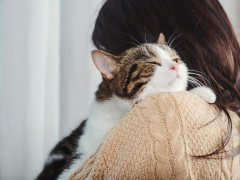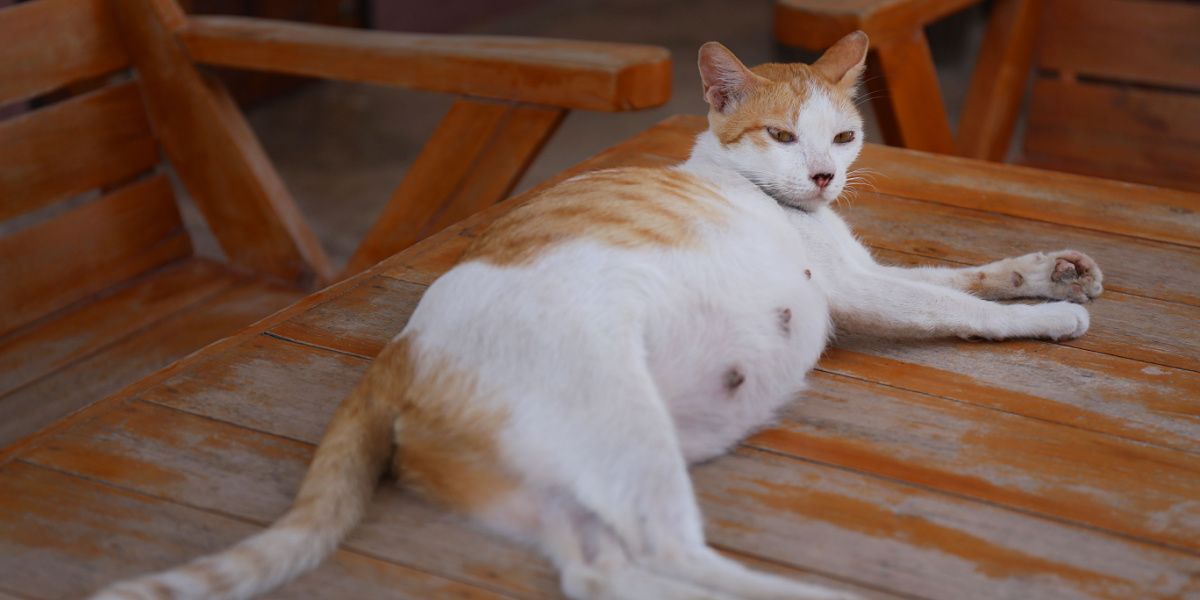
A prolapsed uterus in cats is also referred to as uterine prolapse. It happens when the uterus (womb) of a female cat (queen) is pushed inside out, out of the rear end of a cat, so that it protrudes out of the vulva. This is an obstetric emergency that needs urgent veterinary attention to save the cat’s life. Read on to learn more about this concerning condition.
Quick Overview: Prolapsed Uterus in Cats








How Common Is a Prolapsed Uterus?
A prolapsed uterus in cats is rare. It is not a risk at all to spayed female cats, and it is never seen in non-pregnant female cats. It nearly always happens at the end of parturition (the birthing process), after the last kitten has been passed.
The incidence is higher if there is dystocia (difficulty passing kittens) and if there has been manual intervention to help kittens to be born. In theory, it could happen if a pregnant cat was suffering from an abortion.
It can affect all domestic cats but is more common in pedigree breeds such as Siamese or Shorthair. This is likely because they are more commonly kept for breeding.
Why Is the Condition Called Prolapsed Uterus?
The word “prolapse” comes from the Latin word for “to fall out.” So if an abdominal organ (like the uterus, the intestine, or the bladder) is “prolapsed,” this means that it has “fallen out” of the abdomen.
In the case of the uterus, the prolapse happens through the vulva. This means that the uterus is turned inside out by the cat pushing to pass kittens. The eversion of the uterus is a bit like a sock being turned inside out.
How Do Cats Get Prolapsed Uterus?
When pregnant queens strain to push newborn kittens out of the uterus through the vulva, the pressure inside the abdomen increases.
Usually, the uterus stays in place despite this pressure. Sometimes the internal attachments (ligaments) between the uterus and the abdominal wall loosen, and the uterus itself is pushed out into the outside world.
What Are the Signs of a Prolapsed Uterus?
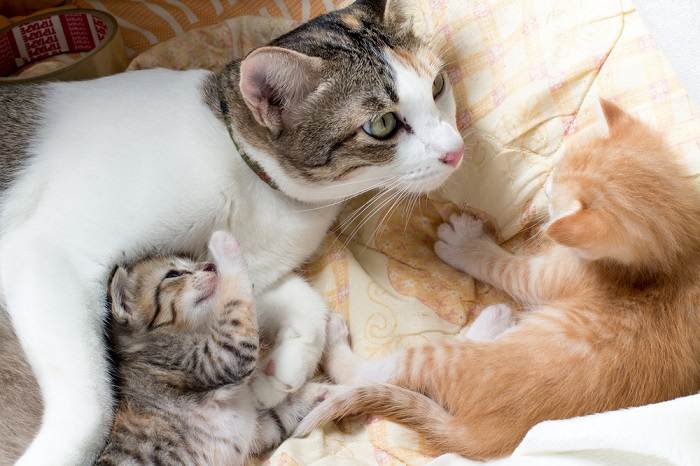
Signs of a prolapsed uterus are very obvious, making it clear when a cat is in need of medical help.
The signs of a prolapsed uterus are very obvious and dramatic: a large, red, fleshy object protrudes under the cat’s tail, emerging from the vulva. One or both horns of the uterus may be seen.
An affected cat may also be struggling to pass urine (dysuria) due to obstruction of the urethra by the prolapse. Tenesmus (straining, and pushing, with the abdomen contracting) may also be seen.
Cats with this problem are often, inappetent, and in pain.
Diagnosis of a Prolapsed Uterus
The signs of a prolapsed uterus are so obvious that an immediate visual broad diagnosis is easy to make. A cat with this problem needs to be urgently rushed to the veterinarian. If you have an Elizabethan collar at home, apply it to your cat on the way to the veterinary clinic to stop the cat from self-damaging the protruding organ.
Your veterinarian may take the following actions.
1. Detailed History Taking
As in every veterinary medicine case, your vet will discuss every aspect of your cat’s life and health care. This includes questions about the cat’s reproductive history (when the cat was in season, when mating took place, etc.), and recent habits (eating, drinking, passing urine and feces, etc).
They will also ask you for precise details on what you have noticed happening to your cat in the previous 12 – 24 hours (did you notice a vaginal discharge, was the cat straining, etc).
2. Physical Examination
Your veterinarian will check your cat over carefully, examining the protruding uterus, and checking your cat’s general health at the same time. The vet will determine first, that the protruding object is definitely the uterus (it could be just vaginal prolapse, or it could even be the lower bowel), and second, if there is one uterine horn or both uterine horns involved.
They will also assess the degree of damage to the uterus (necrosis, or death of the living tissue, may be affecting parts of the protruding organ, or uterine rupture may even have taken place). Your cat may be in shock, and your vet will assess this by examining your cat’s mucous membranes, listening to the heart, etc.
3. Routine Blood Tests
Your veterinarian will likely suggest blood tests, including the usual panel of diagnostic tests, such as hematology (blood count) and biochemistry profiles. This will confirm that there is no other underlying issue making your cat ill.
4. Diagnostic Imaging
X-rays and an ultrasound may be carried out to establish more precise details of the prolapse. They also shed light on any other relevant factors, such as the possibility of the urinary bladder being included in the prolapse, the presence of fluid in the abdomen, etc.
Treatment of a Prolapsed Uterus
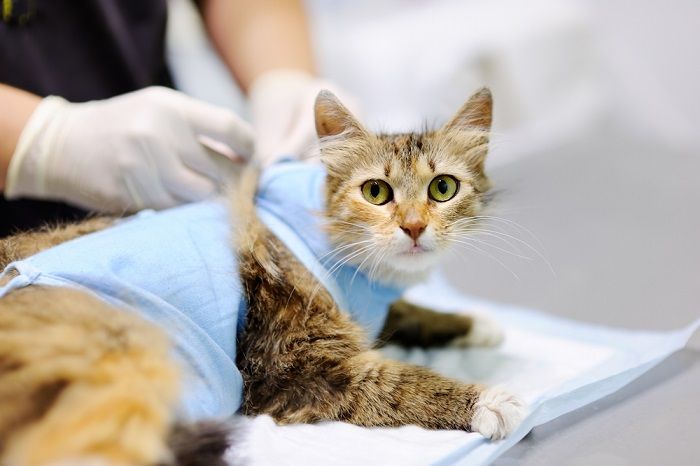
In most situations, the removal of the prolapsed uterus is the best procedure to help the cat’s prognosis.
Normally, the prolapsed uterus will be surgically removed. In theory, it might be possible to invert the uterus and return it into the abdomen through the vagina, then through the cervix, and back into its normal anatomical position. An episiotomy (widening of the vulva using surgical incisions) would be likely to be needed if this was attempted.
In practice, cats are such small animals and the prolapsed uterus is so large, that this would not be practical. Most owners do not want to breed from their cats again anyway, due to the risk of recurrence. It makes sense to just surgically remove the uterus.
A laparotomy is usually carried out to achieve this, first removing the ovaries (ovariectomy). An incision is then made in the cervix, releasing the uterine body so that the excised organ can be removed (hysterectomy). Many case reports and open reports in vet med publications describe how this procedure is carried out if any readers would like to learn more details.
Ancillary treatment, including intravenous fluid therapy for shock, is likely needed. Post-operatively, careful management and observation are important. This means ensuring that normal urination takes place due to the risk of urethral obstruction during the process.
Sutures are put in place after this procedure and need to be removed around ten days after the surgery.
Prognosis for Cats With a Prolapsed Uterus
The prognosis for a full recovery for a cat with a prolapsed uterus is very good as long as prompt, effective treatment is taken. If treatment involves returning the prolapsed uterus to its normal position, the prognosis is more complicated. There are risks of urinary obstruction, recurrence of the prolapse, hemorrhage from damaged blood vessels (e.g. ovarian artery), and infection/ shock due to the traumatized uterine tissue.
Prevention of a Prolapsed Uterus
The best way to prevent a prolapsed uterus is to spay female cats (i.e. carry out ovariohysterectomy) before they become pregnant.
Conclusion
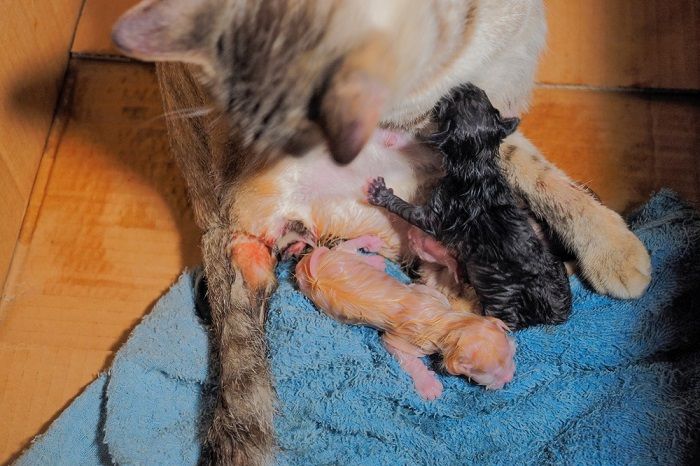
The only sure way to prevent a prolapsed uterus in a cat is to neuter them.
A prolapsed uterus is one of the risks for a cat that is having kittens. All owners of cats that are going to have kittens should be aware of this risk, and familiar with the steps that need to be taken to resolve this life-threatening problem.
Also Read: Nesting Behavior In Cats: What It Is And Why They Do It





